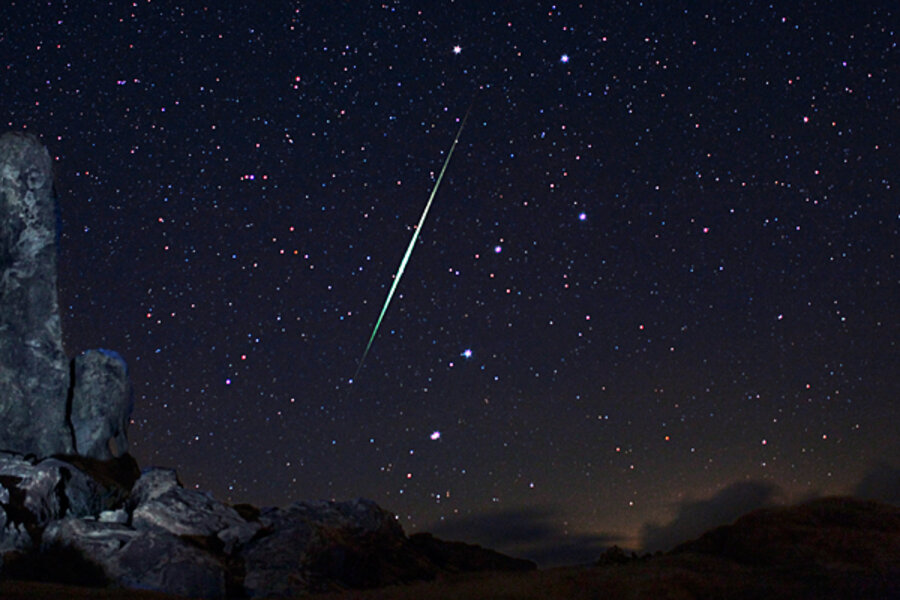Arizona meteor totally unrelated to tonight's eye-popping Geminids
Two things are true: (1) A "fireball" meteor lit up Arizona skies Tuesday night. (2) The most dramatic meteor shower of the year is expected to peak tomorrow night. But despite their coincidental timing, they have nothing to do with each other.
By all accounts, the Arizona fireball meteor was impressive, flaming orange-red and delivering a sonic boom or two that rattled windows and prompted more than one "What was that?!"
The fireball was unrelated to the Geminid meteor shower, a large and impressive meteor shower that has been known to include fireballs and other dazzling light displays. Think of it like this: Not all the drivers on the road at 6 p.m. are commuters. Some are long-haul truckers, some are unemployed people running errands, and some are lost tourists.
How can scientists be so sure that the fireball isn't related? "It's pretty easy," says Bill Cooke, a meteor scientist with NASA. "We rule it out on speed and direction."
Tuesday night's fireball passed by two meteor cameras, says Dr. Cooke, enabling scientists to measure the speed and the direction of its motion. "A Geminid would appear to be coming from the constellation of Gemini – hence the name, Geminid – and it would also be moving 35 kilometers per second (78,000 miles per hour). The Arizona fireball, when it hit the top of the atmosphere, was not coming from the constellation of Gemini. It was coming from a radiant north of that constellation, and it was moving only 20 kilometers per second (45,000 m.p.h.), so that automatically meant it was not a Geminid."
On any given night, you can expect to see five to eight meteors per hour, says Cooke, who leads NASA's Meteoroid Environment Office. Those make up the "sporadic background," unrelated to any meteor shower. Arizona's fireball was one of those, he says.
Meteor showers deliver a much busier sky. At its peak Friday night and Saturday morning, the Geminids will average 100 to 120 meteors per hour, though the nearly-full moon will hide the fainter ones this year.
"It'll still be a very good show," says Cooke. "Our meteor cameras depicted at least 15 bright meteors – almost fireballs – last night, and we're still a night away from the peak." He recommends heading out after 4 a.m., when the moon sets, for the best observing.
Meteor showers occur when Earth's orbit passes through the breadcrumb trail left behind a by comet. (Well, most meteor showers. Maybe not the Geminids. We'll get back to that in a second.) The glowing tail that gives comets their distinctive look is full of gases and bits of dust and rock splintering off from the comet's central nucleus.
Meteor showers start with only a few extra meteors per hour, as Earth passes through the outer edge of the debris trail, then ramp up to the "peak" observation time, when we're in the thickest part of the trail, and then taper off again. This year, the peak will happen overnight Dec. 13-14. During the peak, Cooke and a team of NASA astronomers will host an overnight web chat from 11 p.m. to 3 a.m. EDT.
When Earth passes through these cometary leftovers, they burn a path through our atmosphere. Most completely vaporize before they hit the ground, but those few that do reach the surface leave meteorites, brown or black rocks as old as the solar system itself.
"Most meteor shower events, we don't expect to see material fall all the way to the ground," says Meenakshi Wadhwa, who directs the Center for Meteorite Studies at Arizona State University. Of the 50-100 tons of space debris that Earth encounters each day, she says, only a tiny percentage will make it to the surface.
But she still loves to watch them fall, she says. "These are materials from outer space, leaving a trail through the atmosphere, so that's a spectacular thing to watch."
So, do the Geminids fit the cometary origin story for meteor showers? It's not entirely clear. The Geminids are fragments from an object named "3200 Phaethon," which has some cometary characteristics but has the composition of an asteroid.
"We don't think of asteroids as objects that shed off materials like this," says Dr. Wadhwa.
Cooke says, "3200 Phaethon is an interesting object. It seems to show comet-like activity when it's close to the sun, but dynamically it appears to be an asteroid. It's kind of funny."
Wadhwa describe 3200 Phaethon as a "transitional object ... that you can't put cleanly into the box marked 'asteroids' or 'comets.' It's something in between."
Cooke says, "It's possible that the Geminids are the result of the breakup of Phaethon some time in the past, or a collision between Phaethon and another object, and what we call the Geminids are the debris of that collision that the earth encounters every year."
But whatever their origin, he adds, "The Geminids are the generally best show of the year. If you can, go out – bundle up! – and take a look at them."






